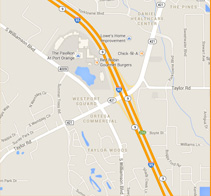News Archives
Volusia County posts an update on Hurricane Ian.
Written by Kristen Schmutz
Belden Communications News
Officials with Volusia County have posted an update on Hurricane Ian, which officially became a Hurricane with sustained wind speeds of 75 mph Monday, September 26.
According to the update, the situation is serious for East Central Floridians. There continues to be a great deal of uncertainty in Ian’s trajectory. Models continue to have the storm’s center of circulation entering the west coast of Florida, anywhere from north of Tampa to Big Bend to the Panhandle. The probability for tropical force winds for Volusia County has increased to 56% and hurricane force winds to 7%. The storm will be a significant rain event for Volusia County.
The storm will intensify, becoming a major hurricane by the time it enters the southeastern Gulf of Mexico, says the National Weather Service. Its forecasted track has shifted east since yesterday and should hit the lower section of Florida’s Big Bend. Much of East Central Florida is at some risk. Further track shifts to the east are not out of the question.
For East Central Florida, tropical storm watches (for wind) are now in effect for all inland counties and Lake Okeechobee. There is a threat of tropical storm force winds with hurricane gusts – with an increasing concern for hurricane winds north and west of Interstate 4. Also, there is a multi-day threat of widespread flooding, rain, and tornadoes.
Depending on the exact track, an additional five to eight inches could occur this week, with locally higher amounts up to 10 to 12 inches in spots. There is a considerable threat of dangerous flooding; flood watches are forthcoming.
Sandbag information is constantly changing, and county staff will update the list of sites at www.volusia.org/sandbags.
Residents are encouraged to develop a family plan and take steps to safeguard their homes. Start by filling up your gas tank, stocking up on food and water, removing debris and furniture from your yard, and filling prescriptions.
Step 1: Make a family plan.
Have a family meeting to talk about the hurricane. Decide where the family will stay during the storm. Together, develop a list of preparation tasks.
Step 2. Stock a disaster supply kit.
Your disaster supply kit should include:
- At least one gallon of drinking water per person per day for five to seven days
- Nonperishable food for three meals per day per person for five to seven days
- A five- to seven-day supply of special items such as food, formula, diapers, and wipes for infants and those with special needs
- At least a two-week supply of medications
- Toiletries and extra toilet paper
- Manual can opener
- Paper goods such as plates, cups, napkins, and utensils.
- Unscented household bleach and medicine dropper
- Extra bedding such as pillows, blankets, and sleeping bags.
- Clothing, including rain gear and sturdy shoes
- First aid kit, sunscreen, and hand sanitizer
- Mosquito repellent with DEET
- Flashlight and extra batteries
- Battery-operated radio
- Tool kit including cord, rope, hammer, wood nails, saw, hatchet or axe, crowbar, chain saw blades, tarp, duct tape, rake, bucket, mop, broom, and heavy work gloves.
- Plastic trash bags and ties
- Fire extinguisher
- Matches in a waterproof container
- Extra charcoal or propane for outdoor cooking
- Hazard alert radio
- Extra batteries and car charger for cellphone
- A canned tire inflator for punctured tires
Your pet disaster kit should include food, water, bowls, leashes, toys, bedding, carrier, medications, newspaper, cat litter, plastic bags for handling waste, and license and vaccination documentation.
County officials are currently exploring the possibility of providing shelters for people who cannot evacuate elsewhere or ride out the storms at home. It’s important to note that shelters should be used only as a last resort. They do not provide luxury accommodations, and if your residents plan to stay in a special needs shelter, they should register now by calling 386-258-4088 or downloading a form from www.volusia.org/emergency.
Residents can call the Citizens Information Center at 866-345-0345 from 8 a.m. to 5 p.m. Monday, September 26, and Tuesday, September 27. If needed, the center will be open for additional days.
Residents should continue to prepare for the storm, fill up their gas tanks, and tune in to local media outlets and www.volusia.org/pin for updates.




